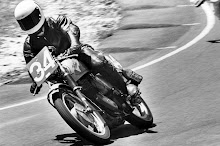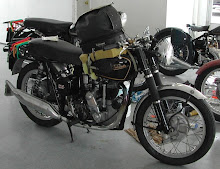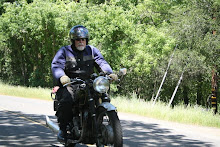The Velocette name is the name associated with the Goodman family with Percy Goodman likely most well known for his OHC design's and the Velocette success in racing.
But as "Titch" Allen mentions in his book..."The Velocette Saga", published over a 16 month period around 1969 in the UK Motorcycle magazine "MotorCycle Sport" then as a hard cover book in 1994...Percy's younger brother Eugene was almost a shadowy figure in the background at Veloce Ltd who was concerned at the amount of business the company was doing....sales had fallen in the early 1930's to a half, even a third of the business done in the late 1920's. He set about and designed a pushrod 250 OHV machine which could be built more economically than the OHC models the company had pinned their hopes on and perhaps was the idea of the "everyman" machine that he later came to be more well known for, the LE Velocette.
According to Ivan Rhodes in his book "Technical Excellence Exemplified"-Velocette, the first MOV was invoiced in October 1933 to W.Tiffin the Carlisle Velocette dealers, engine and frame number 1.
This is interesting as in "The MotorCycle" 15th June 1933 there is a full double page advertising spread heralding the new MOV with dealers adverts, presumably where you could obtain one...
"The MotorCycle" also road tested it further in the magazine.
By December 1933 some over 400 MOV's were dispatched to dealers and presumably impatient customers who may well have pestered the local dealer from June.
The MOV became the start of the pushrod OHV series of Velocettes made up to their cessation of business in February 1971.
In fact the timing chest cover, called "The map of Africa" cover was used on all of these OHV Velocettes.
Following are extracts from Titch and Ivan's books as well as Dave Masters "Illustrated Profile of Velocette Models", which give some insight into the development of this Velocette that was, as mentioned, the fore runner of the OHV Velocette.
The MOV proved a very successful engine to race in the 250 class world wide.
The Holmes family in the UK raced MOV's with great success, which I have little information on but their success is related in Titch's book, pages 82-85.
Earlier in Australia, pre-war, the foreman of the NSW Velocette distributor Tommy Jemison was sent a bronze head from Veloce and he won many events on with this on his MOV racer, including the Australian and NSW GP & TT 250 races at Bathurst,NSW in 1934,35,36,38, culminating with the 250cc Australian Land Speed record of 101.123mph ( approx.100mph one way, approx.102.5mph the other) set at dawn on the Hume Highway ( closed to the public for the attempt) at Leppington, south of Sydney, NSW on 20th December 1939.
Jemison had held the previous record from 17th August 1935 at 92.52mph.
Ewald Kluge on the factory supercharged DKW in Australia in 1938, made an unsuccessful attempt to better the 92.52mph on the Northcott Road, Canberra ACT.
To better the record you had to beat it by 2mph. Kluge achieved 94.24mph.
Immediately following this attempt, Jemison made his new higher speed.
Jemison's record stood until January 1973 when it was broken by Bryan Hindle on a streamlined Yamaha at 125.252mph on a salt lake in Western Australia.
Jemison is pictured on the bike below.
Jemsion during the 1935 record attempt.
Jemison on the MOV in road racing trim.
In the late 1940's Sid Willis had a 250 OHC Velocette racer and obtained a prewar DOHC factory Velocette head and cambox. He became really hard to beat with this setup. On his one European campaign in 1953 he finished 5th in the Lightweight 250 IOM TT...the first privateer home, on the DOHC 250 Velo.
To attempt to beat Willis, South Australian rider Les Diener converted his 250 OHV MOV racer to a DOHC set-up.
At the same time Sydney racer Ted Carey also converted his 250 MOV to a DOHC setup.
Great racing battles occurred with victories to both these riders in the time into the mid 1950's.
Pictured is Les #31 on his DOHC 250 MOV leading #15 Alan Burt on a Waggott engined 250 DOHC Velocette at the Mildura races in Victoria.
Pictured is Les Diener on his 250 DOHC MOV..."Eldee".
Following Les's retirement from racing he moved to other things and his Eldee was sold on...then later restored. Unable to buy it back in the 1990's, Les set about remaking the bike...Eldee 2 was created.
They are pictured together below....
Eldee 2
Ted Carey in action in early 1950's
Ted's engine in early 2000's
Ted's engine, owned my Malcolm Sullivan since 1960's and restored into a modern classic racer.
Subscribe to:
Post Comments (Atom)



















..a.jpg)










2 comments:
Dennis,
I've been meaning to check out your blog in more detail for some time and this lazy Saturday morning I've managed to remember to do so.
I was good friends with Les Diener in his later racing years. In fact I bought his most successful pushrod MOV racer just after he finished building Eldee 2. He decided to sell it because "how can I compete with two 250s at once?"
We travelled together often to MT Gambier's Mac Park and stayed in town as Les had never liked camping, not even in the days he rode seriously.
On those lengthy trips I made sure I listened and gained as much engineering knowledge that I could from the man. His metalurgy and engineering knowledge was to prove most useful in my later exploits.
We had some good times indeed and his passing was quite a blow.
That little MOV I bought has quite a history itself.
I've managed to find out that it was owned and raced by one Tom Medlow back in the 50s and we think it eventually passed to Jack Nairne, then Peter Westerman who sold it to Les.
When Les bought it he recognised it as Tom's bike, some of the components, eg close ratio gears, were ones he had made for Tom back in the 50s.
I've tried to detail it's history but that has proven quite difficult with the death of some of the previous owners and the uncertain memories of the remainder.
Unfortunately(?) it has a Tom Medlow-cast drive side crankcase from "Tramways pistons" as Tom described them...I puzzled over how trams had pistons?...until I realised that the old name for the Adelaide public transport system, busses and trams was the Municipal Tramways Trust, hence "tramways pistons"
So there is no engine number with which to trace it's arrival in South Australia. Keith Milich has done some detective work on Borgelt's imported MOV engine numbers but without the drive side case it is of no use to me. I should chase up Tom Medlow as I hear he is still around so I might have some luck with that missing number.
Problem is, as you would well know, getting around to all the little things is not easy to do!
Check me out on my small website and I promise I'll follow your blog more closely in future!
Regards,
Greg Summerton
http://www.eurospares.com/greg.html
Dennis,
I've been meaning to check out your blog in more detail for some time and this lazy Saturday morning I've managed to remember to do so.
I was good friends with Les Diener in his later racing years. In fact I bought his most successful pushrod MOV racer just after he finished building Eldee 2. He decided to sell it because "how can I compete with two 250s at once?"
We travelled together often to MT Gambier's Mac Park and stayed in town as Les had never liked camping, not even in the days he rode seriously.
On those lengthy trips I made sure I listened and gained as much engineering knowledge that I could from the man. His metalurgy and engineering knowledge was to prove most useful in my later exploits.
We had some good times indeed and his passing was quite a blow.
That little MOV I bought has quite a history itself.
I've managed to find out that it was owned and raced by one Tom Medlow back in the 50s and we think it eventually passed to Jack Nairne, then Peter Westerman who sold it to Les.
When Les bought it he recognised it as Tom's bike, some of the components, eg close ratio gears, were ones he had made for Tom back in the 50s.
I've tried to detail it's history but that has proven quite difficult with the death of some of the previous owners and the uncertain memories of the remainder.
Unfortunately(?) it has a Tom Medlow-cast drive side crankcase from "Tramways pistons" as Tom described them...I puzzled over how trams had pistons?...until I realised that the old name for the Adelaide public transport system, busses and trams was the Municipal Tramways Trust, hence "tramways pistons"
So there is no engine number with which to trace it's arrival in South Australia. Keith Milich has done some detective work on Borgelt's imported MOV engine numbers but without the drive side case it is of no use to me. I should chase up Tom Medlow as I hear he is still around so I might have some luck with that missing number.
Problem is, as you would well know, getting around to all the little things is not easy to do!
Check me out on my small website and I promise I'll follow your blog more closely in future!
Regards,
Greg Summerton
http://www.eurospares.com/greg.html
Post a Comment